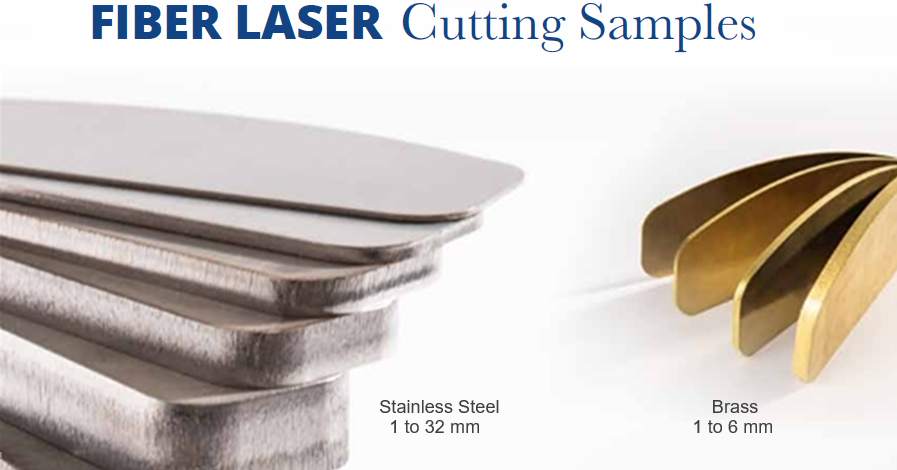Why Choose Fiber Laser?
FIBER LASER
Cutting Introduction
Cutting is the most popular application for industrial lasers. The high precision, speed and quality of laser cutting has made it the technology of choice for advanced manufacturing. Since the introduction of fiber lasers from IPG, laser cutting has become a more reliable and much lower cost solution, resulting in increased adoption of fiber laser cutting throughout the metal processing world.
Since there is no contact between the fiber laser beam delivery head and the metal being cut, the laser light is “a blade than never dulls” and always brings the same repeatable results regardless of how long it is in operation. In comparison with traditional cutting applications like plasma and waterjet cutting, laser cutting results in much higher quality kerf, eliminating the need for part post-processing, thereby significantly reducing overall production costs. Additionally, the amount of material removed in fiber laser cutting can be reduced significantly compared to other methods; this precision enables microcutting applications that are simply not possible by any other means.
In addition to the improved cut quality, better process repeatability and ease of automation benefits, IPG fiber lasers and cutting heads provide additional levels of process control, versatility, waste reduction and significant operating cost reduction.


BENEFITS OF FIBER LASER CUTTING
THE HIGHEST IN RELIABILITY
IPG fiber lasers bring a new level of reliability and ease-of use to laser cutting. Fiber lasers are entirely solid state, with no mechanical cavity resonators or mirrors and no adjustable or replaceable parts within the laser. Light is output along a flexible optical fiber that is plugged directly into the laser cutting head, eliminating the need for optics and adjustments in the beam delivery path.
THE MOST ECONOMICAL
IPG fiber lasers offer the highest wall plug efficiency of any commercial laser. Not only is less electricity consumed in the cutting of parts, but the cooling to remove unwanted heat is also proportionally reduced, decreasing the size of the electrical service needed to support the cutting tool installation.
Achieving over 50% wall-plug power efficiency, combined with improved material coupling characteristics, IPG lasers typically use 70% less electrical energy than traditional CO2 alternatives in metal cutting applications.
Additionally, IPG fiber lasers have a much longer lifespan than other lasers. While other lasers fail after a year or two, IPG lasers continue to cut years after competing lasers have been replaced multiple times.
BEST CHOICE FOR METAL CUTTING
With an emission wavelength of 1 micron, fiber lasers offer higher efficiency and faster processing in cutting metals than CO2 alternatives. An IPG fiber laser cutting 1 mm thick steel is approximately 3.5X faster than an equivalently powered CO2 system. The higher power density and beam quality of fiber lasers combined with virtually maintenance free operation provides reliable and consistent cutting at significantly lower operating costs with overall higher throughput.
At such high-power density levels, metals such as copper, brass and other normally reflective materials go through a phase change into the molten state. This overcomes reflectivity barriers and initiates cutting much more easily than CO2 lasers or near-IR lasers that have only low peak power.
FAST AND PRECISE CUTTING OF SMALL PARTS
In addition to thick materials, IPG fiber lasers deliver very high precision in cutting small and thin parts. Through the use of single-mode lasers, possessing extremely small beam diameters, along with QCW lasers that deliver very high peak power (with minimal heating of the surrounding areas), parts such as medical stents and electronic sensors are easily fabricated or trimmed to size. Using fiber lasers with nano-, pico, and femtosecond pulses as well as those with green wavelengths, cutting of ceramics, glass and polymers with micron-level precision is a high-speed, cost-effective process.
VIRTUALLY MAINTENANCE-FREE
Utilizing rigorously tested, long-life laser diodes, unique active fibers and leading-edge, proprietary technologies, IPG fiber lasers provide greater reliability, less required maintenance and fewer service interventions than competing fiber lasers.

Fiber Laser Cutting vs Conventional Methods


CO2 lasers have been used to provide smooth cutting edges in some thicker materials. With recent breakthroughs including new high power cutting heads, fiber lasers are capable of the same, if not better, results. Fiber lasers cut both thick and thin materials faster than CO2 and are superior in cutting reflective metals, which provides a much lower cost of ownership compared to CO2.


Plasma cutting equipment is typically known to be among the cheapest metal cutting options in the market. When compared to plasma, fiber cutting requires less energy consumption with lower consumables costs. Cutting with fiber lasers improves overall cut precision, quality and production yield, providing superior parts at much lower costs than plasma.
Why are more manufacturers are turning to cutting with fiber lasers as opposed to traditional and more conventional methods?
Manufacturers have several metal cutting methods to choose from, each having their own benefits and advantages. Worldwide, more manufacturers are cutting with fiber lasers due to their increased uptime and throughput, lower operating costs and overall improved quality.


When it comes to cutting extremely thick materials (>25 mm) waterjet cutting can be very effective. In all other cases, fiber lasers provide much higher part throughput, more consistent quality and decreased downtime compared to waterjets as well as no liquid waste that requires proper disposal.


While electrical discharge machine (EDM) cutting is not very well known, it provides excellent accuracy and minimal heat damage to materials. Moreover, fiber lasers offer comparable precision AND are up to 10X faster than EDM cutting - delivering much higher output and productivity.

A wide variety of materials & thicknesses
While lasers can be used to cut nearly any material, metal cutting is the most common application.
Whether it be steel, or reflective aluminum, brass or copper, lasers provide unmatched precision and speed for the cutting of simple and highly complex geometries.
Clean edges, narrow kerf, low surface roughness and no tool wear through thick and thin metals, consistently and efficiently.

